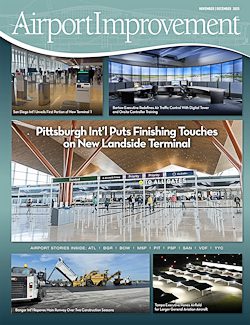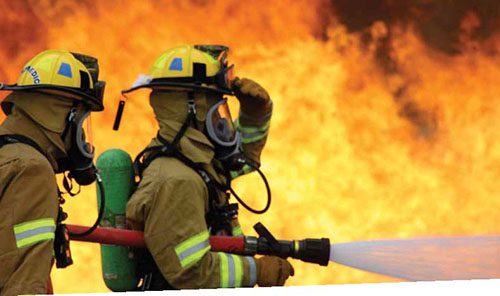 Dallas/Fort Worth International Airport (DFW) recently enhanced its well-established aircraft rescue and firefighting (ARFF) training program with $29 million of updates and renovations to its Fire Training Research Center. A mockup of an Airbus A380, the world’s largest passenger jet, is now center stage.
Dallas/Fort Worth International Airport (DFW) recently enhanced its well-established aircraft rescue and firefighting (ARFF) training program with $29 million of updates and renovations to its Fire Training Research Center. A mockup of an Airbus A380, the world’s largest passenger jet, is now center stage.
“We added the A380 mockup trainer and other advances in technology as a reaction to changes within the airline industry,” explains Alan Black, director of DFW’s Department of Public Safety.
With 86 of the mega-aircraft already in place throughout the industry and Airbus reporting orders for 171 more, DFW officials anticipate keen interest from airports around the globe for hands-on A380 ARFF training. In the past 18 years, more than 15,000 personnel from 24 countries have trained at DFW’s Fire Training Research Center.
|
factsfigures
Project: Location: Dallas/Fort Worth Int’l Airport Cost: $29 million Construction: $22 million Design: $4 million
Funding: Construction: 2 years
Key Features: |
The facility’s new equipment and capabilities, scheduled to available by year-end, are timely offerings. In September, ARFF training was among a handful of “basics” that Kate Lang, FAA deputy associate administrator for airports, mentioned during a Regulatory Roundup session at the Airports Council International conference in Calgary.
“Inspectors have found a spike in noncompliance with basic ARFF training,” Lang related. “We have to keep up on the basics. They second we slack on them, the numbers spike.”
An FAA Airport Improvement Program (AIP) grant paid for fully $19.2 million of the $29 project.
Homegrown Improvements
Recent enhancements at the DFW Fire Training Research Center were championed by the airport’s own firefighters, who also train at the facility. The ongoing evolution of the airline industry, years of experience providing ARFF training to other airports and two major crashes at DFW inspired their suggestions, explains Black. “Generally, they have pushed for more of an emphasis on rescue, or the ‘R’ in ARFF,” he relates. “They believe their calling is to save lives. This belief drove the design of the new facility.”
 DFW Fire Chief Brian McKinney considers the addition of an 18,000-square-foot pit for liquid hydrocarbon fires a key addition, because such chemicals are common at airports (gasoline, fuel oil, benzene, toluene, heptane, etc.).
DFW Fire Chief Brian McKinney considers the addition of an 18,000-square-foot pit for liquid hydrocarbon fires a key addition, because such chemicals are common at airports (gasoline, fuel oil, benzene, toluene, heptane, etc.).
The new 5,000-square-foot fuel spill burn area offers a “unique and realistic three-dimensional fire scenario with obstacles in place for training,” explains McKinney. Designed for handline firefighting (battling blazes without mass application equipment from vehicles; just hoses), it provides valuable experience with real-time flame spread, flame reaction and the unique heat associated with jet fuel, he notes.
DFW’s traditional propane fire pit was also expanded and made more accessible.
“Having two types of fire pits offers ARFF (personnel) the opportunity to train in both situations,” says Black. “This is one of the few facilities in the world that offers both propane and hydrocarbon fire pits.”
The A380 mockup, however, is the feature that’s expected to have ARFF professionals flooding to DFW. Currently, it’s the only A380 trainer in the United States, notes Black.
The aircraft’s 8,000+ square feet of training space includes areas configured for passengers and cargo to provide firefighters with both types of experience, notes McKinney.
Other key features include:
- accurate aircraft height and access dimensions
- multiple access points
- 13 fireplaces with multiple flashovers
- three levels of internal firefighting
- engine, auxiliary power unit and wheel/brake fires
- running hydrocarbon fuel fires
- cargo firefighting level skin penetration points
-
drive-on access near entry points for fire vehicles
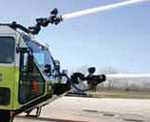 The A380 mockup fireplaces allow trainers to start fires in a variety of locations (nine inside, four outside the aircraft), including the cockpit and main deck. Overall, the new equipment provides students with a “one-of-a-kind, realistic experience necessary to prepare for a real aircraft incident,” says McKinney.
The A380 mockup fireplaces allow trainers to start fires in a variety of locations (nine inside, four outside the aircraft), including the cockpit and main deck. Overall, the new equipment provides students with a “one-of-a-kind, realistic experience necessary to prepare for a real aircraft incident,” says McKinney.
The ability for firefighters to “practice like they’ll play” is a huge advantage of the A380 trainer and DFW’s overall facility, explains McKinney.
Structural additions to the Fire Training Research Center include a 2,000-square-foot Control/Briefing Building and 8,000-square-foot Training Building, which includes a 120-person classroom that can be divided into three separate areas.
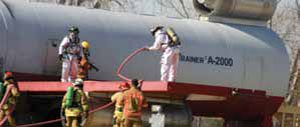 The airport’s original Briefing Building was refurbished to include a galley for trainees.
The airport’s original Briefing Building was refurbished to include a galley for trainees.
Improvements also extended to the airfield. “We’ve extended the taxiway directly into the research facility, making it easier to analyze and fire test new composites in our labs,” explains Black. “We can taxi it right into the facility and then burn it and see its reaction.”
Existing stormwater and sanitary sewer drainage were improved to capture and manage water contaminated during training exercises. Upgrades include a new electronically controlled processing area and updated piping.
Online Options
The addition of virtual training and a new learning management program helped DFW secure the AIP grant that covered $19.2 million of the project.
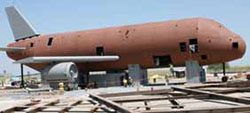 “We’re very excited about the addition of the virtual training, because it will reach students globally,” explains McKinney. “Students will have quicker access to training materials and research.”
“We’re very excited about the addition of the virtual training, because it will reach students globally,” explains McKinney. “Students will have quicker access to training materials and research.”
The training will also benefit vendors, because they can test gear using DFW’s materials, he adds.
“There will still be a need to visit the facility and train on premises,” McKinney clarifies, “but the virtual training will alleviate some financial burdens because students can take some classes online.”
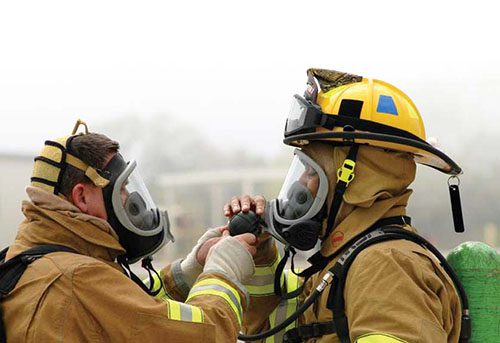 DFW’s new learning management system will allow ARFF professionals to access its training and research materials anytime, anywhere they have an Internet connection. The airport is also rebranding a portion of its website to provide a place for ARFF professionals to share best practices and solutions from the field.
DFW’s new learning management system will allow ARFF professionals to access its training and research materials anytime, anywhere they have an Internet connection. The airport is also rebranding a portion of its website to provide a place for ARFF professionals to share best practices and solutions from the field.
Spreading the Word
DFW plans to officially debut enhancements to its Fire Training Research Center with a grand re-opening in January. In the meantime, Chief Executive Officer Jeff Fegan is ready to share them with the industry: “Our aircraft rescue and firefighting teams are known globally for their excellent training and preparedness, and, with DFW’s newly renovated Fire Training Research Center, we expect to share our research and best practices with airports worldwide.”
 According to Black, customers are clamoring to return to the facility. “The ARFF community is very close-knit, and everyone is very excited for us and wants to be a part of the new facility,” he relates.
According to Black, customers are clamoring to return to the facility. “The ARFF community is very close-knit, and everyone is very excited for us and wants to be a part of the new facility,” he relates.
DFW also hopes to extend its reach well beyond customers and students. Plans are set to conduct research with the FAA Technical Center, and airport officials have already requested involvement from various airlines, cargo carriers and aircraft manufacturers.
“We’ve reached out and invited them to participate and share knowledge as we try to advance safety throughout the aviation industry,” notes McKinney.


